One of the most asked and debated questions in the cinephile community is “What movies should I own in my DVD collection?” It’s a question I’ve asked myself, so I did as any writer does and decided to make my own list of essential movies one should have in their DVD collection. Notice the words ‘dvd collection’; I’m talking hard copies here. And it’s worth mentioning that these are not the only five movies one should have in your collection; nor is it in any way saying you have to own all five.
My aim with this series is to hopefully introduce you to some essential films you may never have heard of or, even better, cause you to reevaluate the ones you have seen. Lists are useful for helping broaden one’s base of knowledge, organizing one’s thoughts, and starting a discussion, after all.
Each entry in this article series will revolve around a specific genre or topic. Because (thankfully) movies are constantly being made, I had to set a cut-off date. What I consider The Essentials will be made up of films released before 2015.
These are the top five detective movies that I believe to be essential to your collection. Everyone loves a good mystery but we love a great detective even more. Once the mystery is solved all we’re left with is the characters. A great detective will have you revisiting the mystery long after it’s been solved. So here are the top five detective movies. But again the cut-off date is 2015, so anything before that is ineligible.
Again, these are not all the essential movies, just some of them.
The Thin Man (1934) – Dir. W.S. Van Dyke
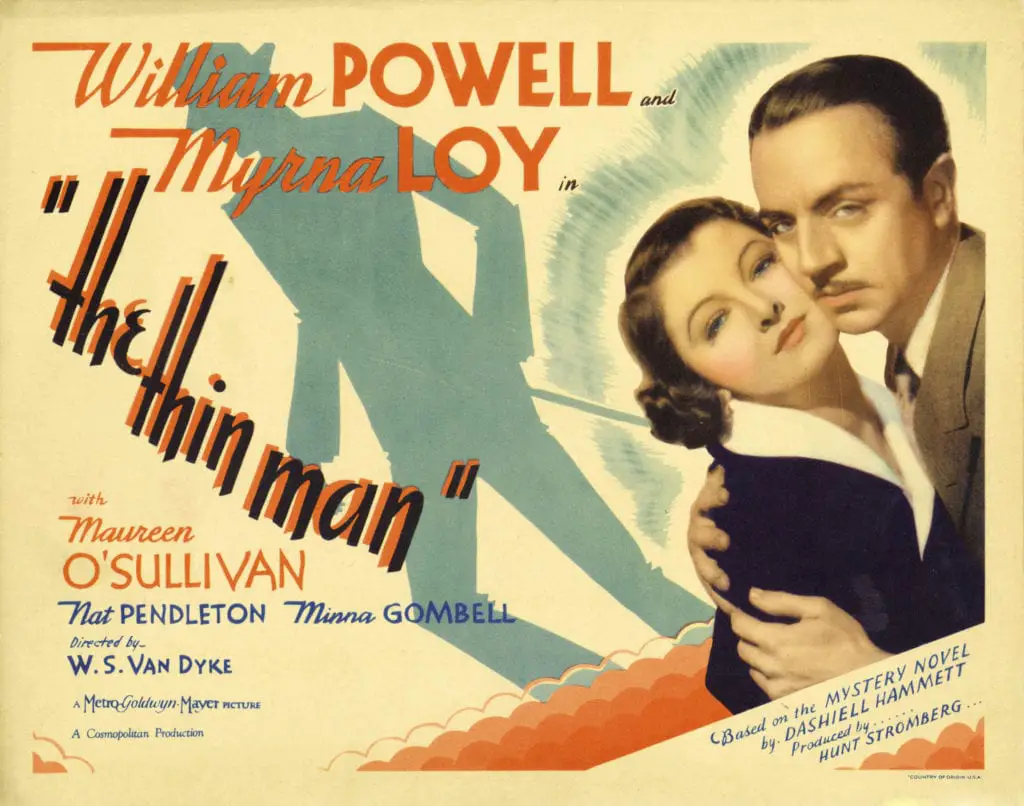
Dashiell Hammett is the father of American detective fiction. The man who gave us Sam Spade from The Maltese Falcon and whose oeuvre was used for the world building of the haunting Coen Brother’s classic Miller’s Crossing. But his greatest creation was the iconoclastic Nick and Nora Charles, the archetype for the rich society couple who moonlight as detectives.
W.S. Van Dyke and his screenwriters Albert Hackett and Frances Goodrich imbue Nick (William Powell) and Nora (Myrna Loy) with sharp tongues and steel livers. Loy and Powell show genuine affection for each other. A rarity for onscreen couples. The two have to navigate a family of rich eccentrics, the Wynats, as well as serpentine through high society. It all culminates in a now infamous, and often copied, scene in which Nick and Nora invite all the suspects to a dinner party to discover the murderer.
The thirties were an odd time for cinema. Hollywood was finally getting use to talkies and understanding how to make them work best. Van Dyke isn’t a virtuoso with a camera but he understands he has a great script and cracker jack talent with Loy and Powell. He chooses to just sit back and let us watch these two verbally spar back and forth. The Thin Man is a gem of the classic Hollywood studio system. It also just so happens to be one of the best and most cleverly written screwball murder mysteries of all time.
Who Framed Roger Rabbit? (1988) – Dir. Robert Zemeckis
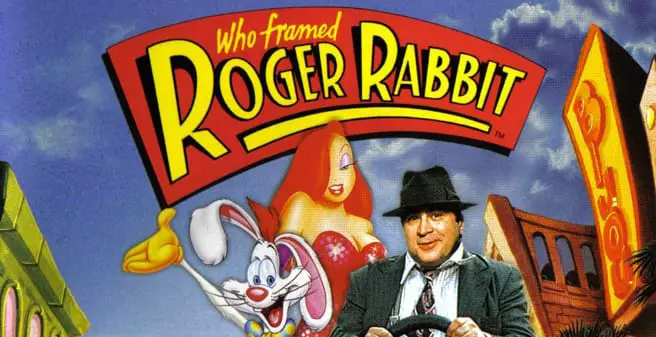
Robert Zemckis will long be remembered by the current generations for the Back to the Future franchise or Forrest Gump. But in 1988 Zemeckis debuted a movie that is truly breathtaking in scope. Who Framed Roger Rabbit? is a technical marvel in the way it seamlessly blends live action with hand drawn animation. But it’s also just a spectacularly well made movie.
Based off the book Gary K. Wolf and adapted by Jeffrey Price and Peter S. Seaman, Who Framed Roger Rabbit? is a film noir, buddy cop comedy, social satire, and family movie rolled into one. Eddie Valiant (Bob Hoskins) is hired by a studio head R.K. Maroon (Alan Tirven) to spy on Jessica Rabbit (voiced by Kathleen Turner). Her husband, and the studio’s biggest star Roger Rabbit (voiced by Charles Fleischer) thinks she’s having an affair. As with most noirs nothing is as it seems.
Bob Hoskins turns in one of the best gonzo but nuanced performances of the decade as Eddie Valiant. A man whose hatred of toons is matched almost by his love of bourbon. Christopher Lloyd’s turn as the vile and genuinely maniacal Judge Doom is breathtaking. His soliloquy at the end about ‘Billboards as far as the eye can see…” is Shakespearean in it’s delivery.
What makes Who Framed Roger Rabbit? so masterful is the joy it has in in it’s own existence. It’s just fun. Chock full of special effects and inventive in camera effects, it never makes you feel as if you are watching a movie about special effects. The characters feel real and the story, wacky though it may be, is treated with seriousness and sincerity. The effects were the means to tell a story and not, as so many films seem to be, a reason to tell the story.
Fargo (1996) – Dir. Joel and Ethan Coen
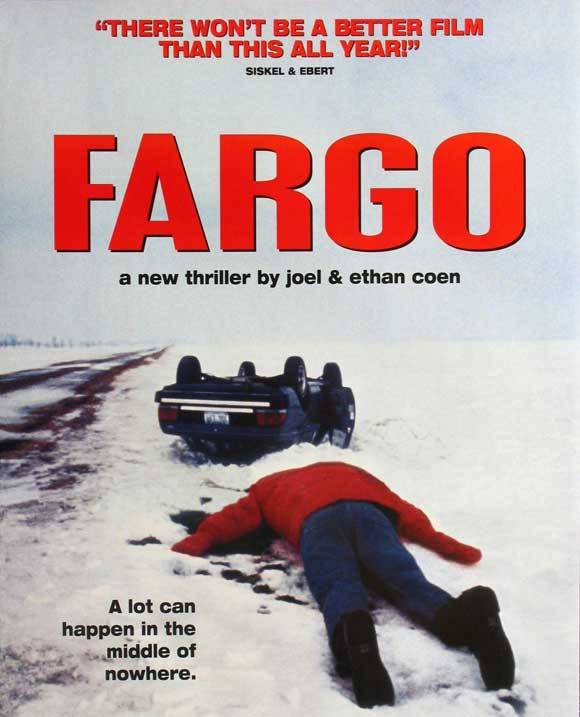
“And it’s a beautiful day too.” – Marge Gunderson
Of all the Coen Brother’s films Fargo stands alone. At times overtly stylistic before cutting to the next scene filmed as a slice of life moment, it’s an American masterpiece. Fargo manages to be almost a different movie with every scene yet each feels a part of a whole. It is a look into the dark heart of humanity but never loses it’s cheerful optimism along the way.
Marge Gunderson (Frances McDormand) is easily one of the best creations of the latter half of the twentieth century. This is due in large part to McDormand’s almost fearlessly cheerful performance. The cinematic landscape is littered with beleaguered, drunken, surly, misanthropic, loners but there is only one Marge Gunderson. Unlike most detectives in movies, Marge is a fully functional adult in a healthy and loving marriage with her husband Norm (John Carroll Lynch); and she’s pregnant to boot.
Less a mystery and more a Greek tragedy Fargo somehow never feels overwhelmed by it nihilism. The Coens seem as taken aback by the callowness on display as Marge does. The music by Carter Burwell seems to fit no matter the mood or scene, despite that fact the score itself never really changes. Fargo shows us the dark side of humanity without relishing in it or succumbing to it. The Coens have made many great films but with Fargo they made a perfect one.
Inside Man (2006) – Dir. Spike Lee
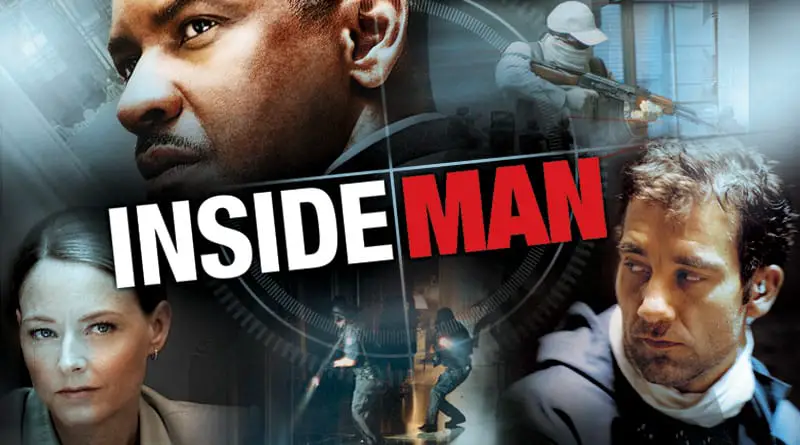
Spike Lee is easily one of the best American auteur storytellers working today. Lee is a deeply talented socially conscious director who is often left out of conversations of ‘great directors’. Lee is unafraid of taking chances or trying new things. Inside Man is by far his most mainstream attempt to date. It’s a heist movie but manipulates the trope of the genre to get at something deeper.
Dalton (Clive Owen) and his crew have taken a downtown Manhattan bank hostage. Dalton doesn’t care about the money, just a particular safety deposit box. Arthur Case (Christopher Plummer) founder of the bank and owner of the safety deposit box is worried about the contents as well. Arthur hires Madeline White (Jodie Foster) as a liaison to make sure nothing happens to the box.
Enter Detective Keith Frazer (Denzel Washington). Frazer has to deal with the demanding Arthur, the curiously connected Madeline, and the enigmatic Dalton, all while also being a black cop in New York City. Denzel Washington, as always, is a joy to behold. With his magnetic and gregarious smile, he struts about the screen in his white panama hat while letting everyone else talk. Frazer nods, listens, and slowly begins to put the pieces together.
Lee and his screenwriter Russell Gewirtz explore race relations, sexism, and cultural differences. They cleverly smuggle these observations into a revenge morality tale. Then go one step further and dress the movie in a slickly produced popcorn heist movie. Inside Man explores these themes without stopping the movie to deal with them. Lee has a distinct idiosyncratic style that heightens the drama but never takes away from it. Inside Man moves so smoothly and effortlessly that as the credits roll we’re left wondering why there’s not a whole franchise of Detective Frazer movies.
In the Heat of the Night (1967) – Dir. Norman Jewison
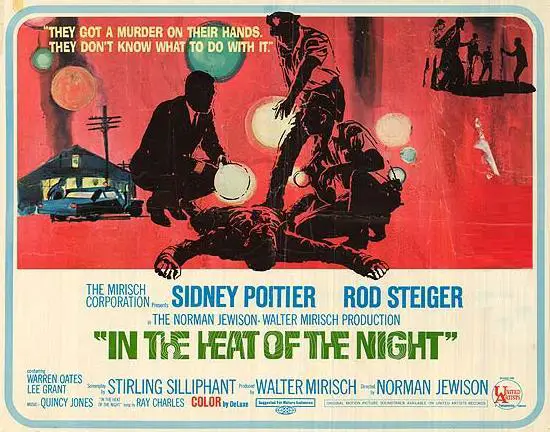
Why exactly In the Heat of the Night is so groundbreaking may be lost on a modern audience. Cinematographer Haskell Wexler was the first to realize that Sidney Poitier would need different lighting because of the color of his skin. The result being that In the Heat of the Night was the first time in Sidney Poitier’s career that he was correctly lit and visible throughout the movie. The director, Norman Jewison, and his co-star Rod Steiger were from the New York School of theater. For the first time Poitier found himself being asked about what his character thought. It also features the first time a black man slapped a white man onscreen.
Virgil Tibbs (Sidney Poitier) stops off in the small town of Sparta, Mississippi where the murder of a prominent businessman has just occurred. A police officer spies Virgil, a black man at the train station in the middle of the night, and brings him in as a suspect. Once Chief Gillespie (Rod Steiger) discovers that Virgil is a Philadelphia homicide detective passing through, Gilespie does the unthinkable. He asks for help. There’s a tension between Virgil (Poitier) and Gillespie (Stieger) that erupts early on but then begins to cool down to a simmer as the two men begin to trust and understand each other.
Few films make you feel the oppressive heat of the deep south quite like In the Heat of the Night. The heat is visceral as well as allegorical for the racial tensions of the country at the time. Jewison worked on a sparse budget and uses that spareness to show the poverty stricken Sparta, Mississippi. In the Heat of the Night is about racism but not in the classic Hollywood sense. Its message is wrapped in a taut visceral murder mystery. It’s a message movie, but the message is made sharper by giving it a plot and characters to rest its point upon.

